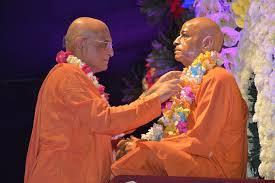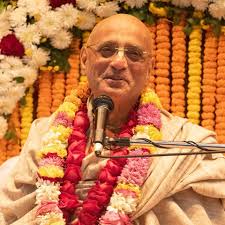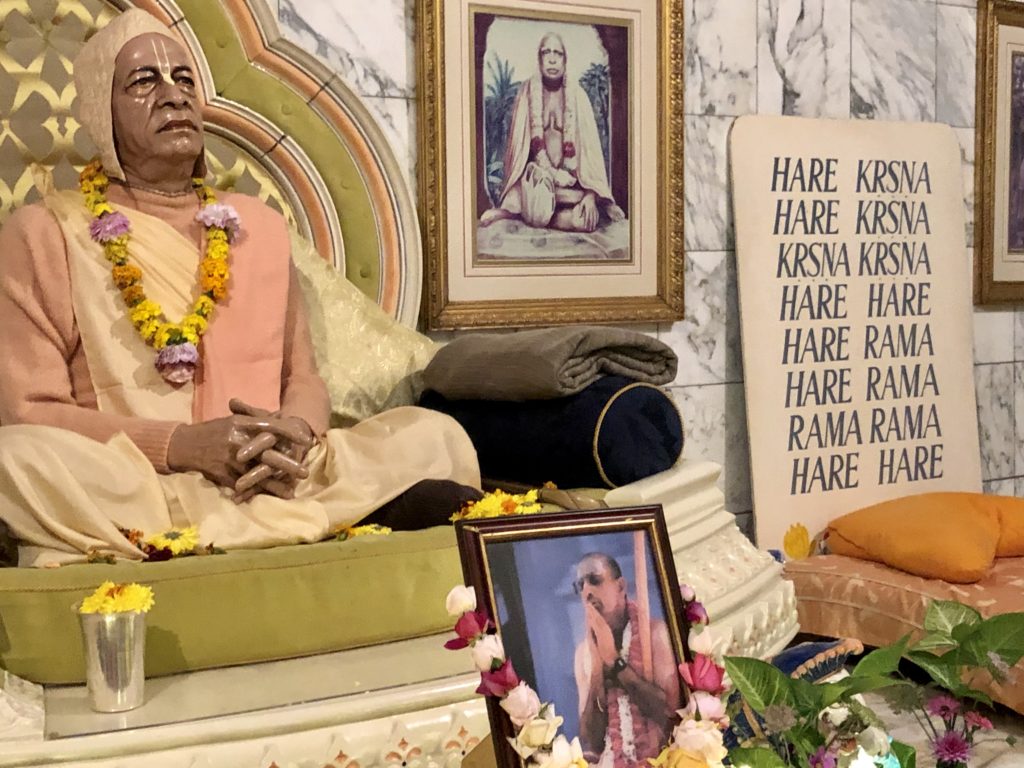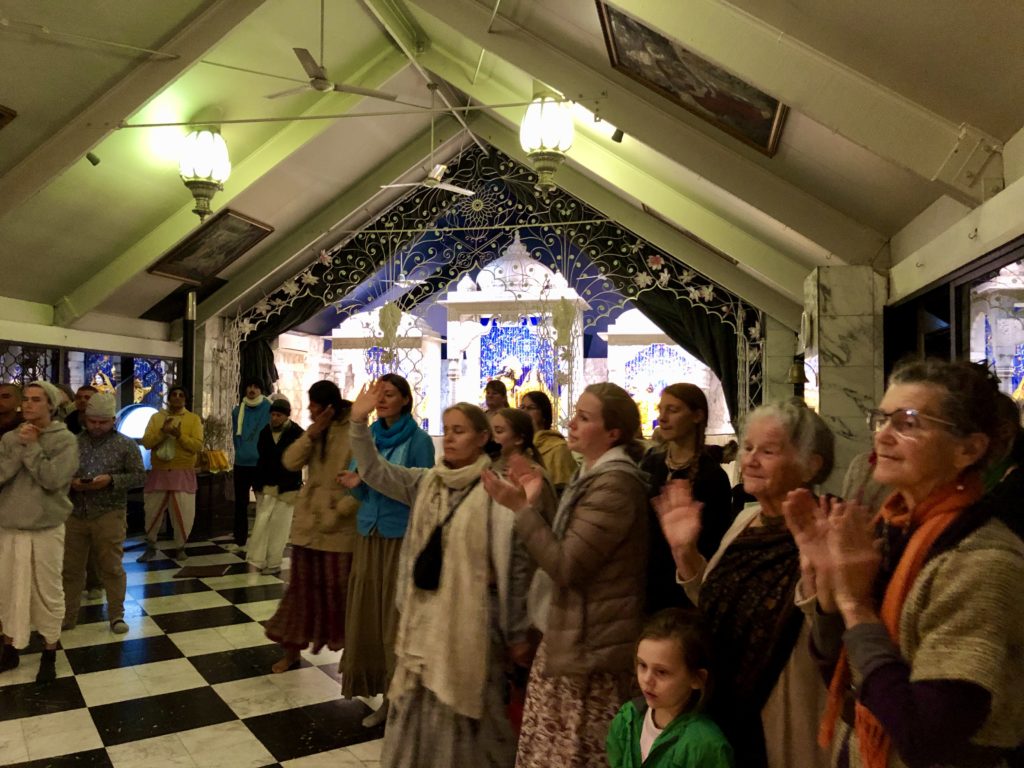
To honor H.H. Bhakti Charu Swami the BBT has released a free PDF of his autobiography, OCEAN of MERCY. Use the link below to download the PDF (52MB).
Websites from the ISKCON Universe

To honor H.H. Bhakti Charu Swami the BBT has released a free PDF of his autobiography, OCEAN of MERCY. Use the link below to download the PDF (52MB).
ISKCON Mayapur requests disciples, devotees and well wishers of HH Bhakti Charu Maharaja to refrain from making travel plans to visit Mayapur for the Samadhi ceremony. Kindly watch this announcement video from ISKCON Mayapur regarding HH Bhakti Charu Maharaja Samadhi ceremony.
The post Important announcement about HH Bhakti Charu Maharaja’s Samadhi Ceremony appeared first on Mayapur.com.

Vaisesika Pr on Bhakti Caru Swami "how to deal with the passing of a great devotee" Towaco NJ 7/5/20
Read More...
Tribute to HH Bhakti Charu Swami Maharaj -| 7 July 2020, Live from Ujjain
Read More... By Giridhari Swami
By Giridhari Swami I had the good fortune of associating with your Guru Maharaja during the 2019 GBC midterm meetings held in Tirupati. Numerous times throughout that visit he would give me a long, warm and loving embrace and say, “My dear old friend, my dear old friend.” And he would reminisce about the times he visited our Hong Kong yatra in the 1980’s when we worked closely together to publish his series of books for children. He called these happy days, when he cooked for the devotees, led kirtan and gave classes to our newly recruited Chinese devotees. He was always very liberal with his association and enlivened one and all. Continue reading "Letter for the disciples of HH Bhakti Caru Swami from HH Giridhari Swami
→ Dandavats"

Sadbhuja Das: Hare Krishna to all,
As you all are aware we have suffered a great loss within the ISKCON community of a wonderful devotee, and amazing Guru to many, HH Bhakti Caru Swami Maharaja.
His sincere and hard work in spreading Krishna consciousness will always be cherished, and appreciated for years to come. Maharaja has always been very enthusiastic, and as far as i can remember always greeted anyone with a welcoming grin, which could melt anyone’s heart.
I will always reminisce on the association which he gave me, as it was always amazing spending time with him. Here are just few photographs of his last visit here at the TOVP site at the beginning of last year.
Although his passing has been painful to many, and a great tragedy at the thought of being unable to have his association anymore, we must be glad that he is now reunited with our founder Acarya along with the Supreme Personality of Godhead.
Bhakti Caru Swami, Ki Jay!
Read More...We are delighted to share that the lock down did not deter the spirits of the team. ‘Moving the deities into Their homes’ is the motto. Capturing the individual and collective contributions herein. Through the duration of the pandemic, the team is at its laborious best to ‘make it happen’.
Click here to see it in your browser or download a copy to your desktop for offline reading.
 By the GBC Executive Committee
By the GBC Executive Committee As we try to come to terms with the departure of His Holiness Bhakti Charu Swami, we join you in eagerly awaiting Maharaja's return to Sri Mayapur Dham where his samadhi will be erected. Due to the ravaging spread of COVID-19 in India, the government will not allow any public ceremonies to take place at this time. Therefore, we request devotees to refrain from making plans to travel to Mayapur. Only a few devotees, those who are directly involved in service, will be able to attend the last rites. This will be strictly enforced by government protocol. Continue reading "Samadhi Ceremony in Mayapur
→ Dandavats"

Sweet Memories (16 min. video)
HH Indradyumna Swami’s glorification of HH Bhakti Charu Maharaja during Maharaja’s memorial festival July 6, 2020.
 By Bhakti Bhringa Govinda Swami
By Bhakti Bhringa Govinda Swami I think that now is the time for us to really take those instructions that we read in Srila Prabhupada’s offering in the Shrimad Bhagavatam to his spiritual master to heart. And that instruction is that he lives forever by his instructions and his disciples and followers live with him. And this is the case for His Holiness Bhakti Charu Maharaj as well. Although it is a great misfortune that we will not have his personal association, his instructions and his example will live for us to get forever. And for myself, Bhakti Charu Maharaj was always an example of intense affection and intense dedication to Srila Prabhupada. I saw that exhibited the first time I had a personal interaction with Bhakti Charu Swami Maharaj, and that was in the summer of 1977 in Vrindavan when we were all serving here, and Srila Prabhupad was bringing his pastimes in this world to an end. Many times while sitting in Srila Prabhupada's room, I would observe how when Prabhupad heeded some comfort, when Prabhupad need somebody to speak to very closely and when Prabhupada wanted to hear the loving words of his disciples, he would call Bhakti Charu Maharaj and they would sit and speak very sweetly and intimately in the Bengali language. Continue reading "Remembrance of His Holiness Bhakti Charu Swami Maharaja
→ Dandavats"

Somehow, by Lord Krishna's too-great-to-understand plan, He has decided to so suddenly promote His selfless servant Bhakti Charu Swami into His eternal Abode.
Read More...

Born in Bengal in 1945, Bhakti Charu Swami spent most of his early life in the city of Calcutta. In 1970, he left India to study chemistry in Germany. Coming across Vedic literatures while in Germany, he discovered the richness of India’s spiritual heritage. In 1975, he returned to India to wholeheartedly pursue spiritual life.
In late 1976, Bhakti Charu Swami joined the ISKCON temple in Mayapur, West Bengal and became more involved in devotional service to the Lord, all the while awaiting Srila Prabhupada’s return to India.
When Srila Prabhupada returned to India, the first direct meeting between guru and aspiring disciple finally took place in January 1977. During that meeting, Srila Prabhupada gave Bhakti Charu Swami the assignment of translating his books into Bengali and then made him his Secretary for Indian Affairs.
Srila Prabhupada gave Maharaj first and second initiation simultaneously in Mayapur on Gaura Purnima 1977. Three months later, Srila Prabhupada awarded him the renounced order of Sannyasa. All of this demonstrates a remarkable investment of authority and blessings from Srila Prabhupada to have occurred in such a short period of time.
Throughout his devotional life, Bhakti Caru Maharaja traveled the world to spread Krsna Consciousness. He also made a film about Srila Prabhupada and wrote a book giving his memoirs of him. He saw all of his achievements in ISKCON as an offering to his Guru Maharaja.
On July 4th, which coincided with the disappearance of Srila Sanatana Goswami, HH Bhakti Caru Maharaja left this world to directly be with Radha and Krsna, Lord Caitanya and Srila Prabhupada. We will miss him dearly.
In one verse from the Srimad Bhagavatam it is said, “O King, no one can know the plan of the Lord [Sri Krsna]. Even though great philosophers inquire exhaustively, they are bewildered.
The best policy is simply to abide by the orders of the Lord without argument.”
“When the Supreme Personality of Godhead arranges something, one should not be disturbed by it, even if it appears to be a reverse according to one’s calculations.”
A nice ceremony was observed at New Govardhana in honour of HH Bhakti Caru Maharaja with kirtan, eulogies, puspanjali, arati and feast.


 By Kanchan Chaudhari
By Kanchan Chaudhari ISKCON authorities had moved the HC, seeking a permanent injunction against Iskcon Apparel Private Limited, a private enterprise, for infringing on its registered trademark. The Bombay high court (HC) on Friday declared that the International Society for Krishna Consciousness (ISKCON) to be a “well-known trademark” that enjoys protection under the provisions of the Trade Marks Act, 1999. Justice BP Colabawalla accepted ISKCON’s argument. “Since it is a coined a trademark, which is associated exclusively with the plaintiff, it, undoubtedly, deserves the highest degree of protection,” said Justice Colabawalla. He said ISKCON has acquired immense and long-standing reputation and goodwill both at home and aboard, while upholding its plea. Continue reading "Bombay HC declares ‘ISKCON’ is a well-known trademark
→ Dandavats"
Posted by Giriraj Swami on Monday, July 6, 2020
Memorial Event for HH Bhakti Charu Swami Maharaj
Memorial Event for HH Bhakti Charu Swami Maharaj
Posted by Bhaktivedanta Manor on Monday, July 6, 2020

Srila Prabhupada spent his entire life's energy to give Krishna to the whole world; and in so doing he also created so many empowered saints, men and women of such pure hearts and saintly characters. Bhakti Charu Maharaj is such an exemplary saintly son, the ideal disciple and perfect follower of Srila Prabhupada. Having given his whole heart to Srila Prabhupada's mission, he was thus blessed with so many of Srila Prabhupada's pure qualities: his deep compassion, his constant selflessness, his humble dedication to the spiritual upliftment of everyone.
Read More...
Ambarisa Das: Farewell my dear, dear friend. I aspire to meet you again at the lotus feet of our Srila Prabhupada.
Read More...
As we know, H.H. Bhakti Charu Swami's support for the IMCPA was very substantial. By his stature among the leaders of our Society, he was able to call attention to the importance of the ministry; he supported it financially; he helped in making favorable legal arrangements for the North American branch of the Ministry; he personally attended a farm meeting in Deland (thereby foregoing his expected participation in London Rathayatra); he helped form the Ministry's board of advisors and, as some of us personally witnessed in Sridham Mayapur this last February, he took part in formation of the Ministry's Council of Elders, thereby hosting the ceremony establishing H.H. Smita Krishna Swami as the Council's first member.
Read More...
Srila Prabhupada makes us understand that ‘a cent-percent devotee of the Lord is immune to the dreadful material miseries of repeated birth and death’ (SB 1.3.39, purport). And ‘service to the Lord is rendered in pure consciousness of one's spiritual identity; by service one is immediately freed from material encumbrances (SB 1.1.2, purport). ‘Because a devotee is freed from all contaminated material association, he is not affected by the miseries of material existence. Even though he appears to be in the material world, he is not affected by the miseries of the material world (SB 3.25.24, purport)
Read More...When devotees at the ISKCON temple in Sydney, Australia, couldn’t organize their regular full-fledged outdoor Rathayatra festival due to COVID-19 restrictions, they decided to bring the whole city of Puri and a new custom-built chariot into their temple room for a small indoor Rathayatra. Carried out in consultation with head pujari Bhaja Govinda Das, the […]
The post Sydney Devotees Construct Detailed Jagannath Puri Replica appeared first on ISKCON News.

Maharaja is universally loved all over the world, and the entire International Society of Krishna Consciousness mourns his passing. Nonetheless, the sorrow we feel at losing the company of such a saintly person is tempered with the joy of knowing that he has gone on to bigger and better things.
Read More...
I still cannot accept the fact that you have left this world. When I had come to know about your health condition, I was sure that you will recover from it. But Krishna had a different plan. Krishna wanted you to return to his kingdom. And no one can interfere in Krishna’s plan because he being the Supreme Lord knows what is best for all.
Read More...
Hrdayananda Goswami says a few words on HH Bhakti Charu Maharaja
Read More... By Bhakti Raghava Swami
By Bhakti Raghava Swami The last time we met was in the month of May, 2018, in California where we were both attending a Cow Culture Conference. It was the first time I was hearing from you about your project in Florida where you explained that in North America we must provide special facilities for cows due to the harsh temperatures. You had recently acquired 120 acres of land for that purpose close to Orlando. I was happy to hear of your initiative to help make more devotees become aware of the importance of cow care. Continue reading "Disappearance of HH Bhakti Charu Swami – Offering
→ Dandavats"

(Kadamba Kanana Swami, 1 June 2020, Radhadesh, Belgium, Caitanya Caritamrta Lecture)
I do not usually cover the topic of disrespecting vaishnavas, as in one sense, it is a distasteful topic. I do not like to discuss all the unpleasantness of vaishnava-apradha as it is not filling our hearts with great happiness. To make vaishnava-apradha the focus of spiritual life is also not what it is about. Our lives must be dedicated to devotional service. Let us just think day and night about expanding our devotional service and about expanding the mercy of Lord Caitanya in all directions. Then in this course, we avoid vaishnava-apradha. But if one is merely spending their life avoiding vaishnava-apradha, that alone is not enough. Let us do something to increase the glories of the Lord and the glories of His devotees. And in this way, we increase the glories of the sankirtana movement.
The article " Increasing the glories " was published on KKSBlog.
 By Bhaktivaibhava Swami
By Bhaktivaibhava Swami I will not attempt to imagine the pain and emotions you are going through at this moment after the departure of your beloved Guru Maharaja. I can only join Anuttama Prabhu's memory of the pain and emotions we experienced when His Divine Grace A. C. Bhaktivedanta Swami Prabhupada left this mortal world. Although we were aware that Srila Prabhupada was very sick at that time, the thought that he could pass away from this world never crossed my mind, not even for a second. Srila Prabhupada was my life and soul - period. When I received the devastating news of Srila Prabhupada's departure while preaching in Beirut (Lebanon) at that time, I was sitting in my room for two days, not being able to eat or sleep or do anything else, except chanting the Holy Name and remembering Srila Prabhupada with tears constantly flowing from my eyes. The whole world collapsed for me. Was there any use to continue? Continue reading "The whole world collapsed for me
→ Dandavats"
 By Bir Krishna das Goswami
By Bir Krishna das Goswami Today is a day of intense mourning, the day that Srila Bhakti Charu Swami left this mortal world, and has gone to serve in His Divine Grace Srila Prabhupada’s pastimes. For a pure devotee such as Bhakti Charu Maharaj there is no lamentation, as he is continuing his service in another location. However, for those of us who will be bereft of his association, it is hard to imagine continuing our lives without him.
Continue reading "A day of intense mourning
→ Dandavats"
 By Vaisesika Dasa
By Vaisesika Dasa Let us offer true homage to Maharaja by continuing his legacy of service in our own lives. Let us commit ourselves, mind, body, and soul, to the service of Srila Prabhupada, following in the footsteps of his beloved servant, His Holiness Bhakti Charu Swami. Continue reading "Glorification of HH Bhakti Charu Swami (video)
→ Dandavats"
 By Bhanu Swami
By Bhanu Swami HH Bhakti Charu Swami was known by all who met him as the most gentle, humble, compassionate and learned devotee. Everyone valued his association. Thus, in his absence there will feelings of great loss for everyone. But for his disciples there will be extreme feelings of vacancy, because of their relationship to him as his dependent, like the feelings of a child on the loss of his parent. Since this relationship is spiritual, the loss is felt even more intense. However, as devotees we also have a special vision, explained in Bhagavad Gita and by Srila Prabhupada. The devotee has no death, no departure. He is the eternal servant of Krishna. Continue reading "May this be some compensation for the loss of his physical presence
→ Dandavats"
 By Prahladananda Swami
By Prahladananda Swami More than anything concerning the disappearance of Bhakti Caru Swami I am solaced by the appreciation of his character and service expressed by his godbrothers and leaders of ISKCON. I believe ISKCON above everything is meant to carry on the vision and mission of Lord Caitanya Mahaprabhu that Srila Prabhupada revealed to the world. However, that vision and mission especially becomes alive in the Krishna conscious loving exchanges between the devotees. Continue reading "Disappearance of HH Bhakti Charu Swami
→ Dandavats"
 By Kesava Bharati Dasa Goswami
By Kesava Bharati Dasa Goswami We’ve just lost one of ISKCON’s most important leaders, His Holiness Bhakti Charu Swami, who succumbed to Covid19 and the complications it brought on. He departed on the auspicious day of guru-purnima, which is also the disappearance day of Srila Sanatana Gosvami, a befitting day for one who relished sharing his realizations of Sri Brhad-bhagavatamrta, even before the BBT published Gopiparandhana Prabhu’s translation. Such was his profound knowledge of sastra. Continue reading "Tribute to HH Bhakti Charu Swami from HH Kesava Bharati Dasa Goswami
→ Dandavats"
Christie Pitts, Toronto
Brother of Gentle Demeanor
This morning His Holiness Bhakti Caru Swami passed away.
Oh Brother of gentle demeanor,
I am your irrefutable junior.
When I look at all you’ve done,
Nothing short of making that homerun,
I am humbled by your limitless energy.
And now you leave us that memory,
Of absolute conviction to go,
Where a target receives a clean throw.
You aim your desires so right,
And anchor turbulence at a fight.
You offer a calm where there isn’t,
And subdue a storm you see as incumbent.
You go out of your way to cook for us,
At no inconvenience and with no fuss.
Last time you sat with me at Pune’s veranda.
(It could have been anywhere, even Uganda.)
You took the time to comfort, offer assurance.
When confusion prevails you present balance.
You are a gentleman so rare to find.
Even ruffians in your presence become kind.
You serve food daily to many, many children,
Fill bellies, fill hearts amounting to millions.
Vast attention comes running to you,
Especially when you put Prabhupada, centre in queue,
And set the tone with finesse and manners,
At such time when inclusiveness matters.
The world finds it hard that you’re suddenly gone,
Like the sun that’s up, then abruptly left for long-
May the Source be with you!
6 km
Queens Park, Toronto
To the Sane
The other day, when I walked with Nick eastbound on Bloor, the street lights allowed for seeing all that happens on the sidewalk. By observation the night hours do often bring out the craziest elements.
One fellow, on something, decided to execute a version of push-ups. No problem, however, his positioning was north-south and occupied most of the sidewalk. Oblivious to the pedestrians’ thoroughfare, we were forced to walk around Mr. Fitness-on-a-whim.
Not five minutes later, another fellow, on something else, lay with his back on the sidewalk. Was he out like a light? Apparently not. As he saw me coming, he rose at the waist and raised his arms.. An Ali Baba greeting or something? I’ve received that type of protocol before by people in jest.
Moving farther along, with Nick and a young Oriental woman in modern attire caught up to us and silently walked abreast of us for several blocks. Perhaps it was her usual pace. At the juncture on University Avenue, Nick and I decided to just plop ourselves on the stairs of the “Church of the Redeemer,” but our new walking companion halted herself along with us and begin uttering remarks about how “everything is so cool.” She just hung out with us for a few brief minutes with no introduction. What was she on? We parted and noted the eve of instability.
Tonight, I sat on a park bench at the same above-mentioned time. However, this time with more sane circumstances. We were thinking about our dear Godbrother, Bhakti Caru Swami, who is deeply struggling with the Covid 19 virus. I offered a prayer: “Dear Krishna, if You so desire, please allow Bhakti Caru Swami to remain with us in service to You.”
May the Source be with you!
4 km
https://www.instagram.com/p/CCN4ZaoA8QR/
St. Jamestown, Toronto
Disarm
Sanjit and I took, as our route, the Ancient Trail currently known as Davenport. It is a winding roadway—the edge of an escarpment where Huron-Wendat natives trekked and met explorer Etienne Brûlée. It’s hard to imagine the world of the past, when all was green, raw and untouched.
Our destination was Sherbourne and Wellesley, by the library, which is at present closed. There we met Michaela from Croatia. As a film/camera person by profession she has offered to work with me on the next drama “Rolling the Dice,” based on the epic “Mahabharata.” During our glance over the script and exchanging of ideas for upcoming camera work, a phone call came in from India. It was Pariksit, who acts as an assistant director for productions I’ve done recently. This call rather fell in place at the right time because “the play is the thing.”
One pedestrian, who could be, at my guess, based on their attire, an Ethiopian woman, took incredible interest in our mini pow-wow at this outdoor destination. I guess she really was curious about my robes, however, I had to defer her to Sanjit to explain, as best he could, what Krishna consciousness is. Well, he tried and, having lived in Africa, he began to converse in her language. They hit it off right away! I could sense she was charmed.
Some minutes later a young shirtless man (could have been the same lady’s son) approached me in a most challenging tone.
“What can you tell me about spirituality?” he demanded while trying to gain a foothold as he staggered.
I’m not sure what he was on but I took the disarming approach saying, “I’m really just a beginner,” which is true. His aggressive attitude softened.
May the Source be with you!
6 km
Tributes from Bhakti Caitanya Swami, Jayadvaita Swami and Giriraj Swami.
 By Partha Sarathi Das Goswami
By Partha Sarathi Das Goswami Our ISKCON, as Srila Prabhupada has stated in a commentary in Caitanya Caritamrta, is non-different from the pastimes of Sri Caitanya Mahaprabhu. Still, it's natural for the disciples to feel separation from the spiritual master. And it's sad that we can't be together giving each other support, but you are all in my thoughts and prayers. It's important that we all carry Maharaja's mood and instructions in our heart and act in a way that will please him. Maharaja was so full of love and compassion, always enquiring about one's welfare and making arrangements to accommodate devotees of all stature. Continue reading "Homage to His Holiness Bhakti Charu Maharaja
→ Dandavats"

We are deeply saddened as Om Vishnupad Bhakticharu Swami Maharaj passed beyond the veil on 4th July, 2020.
Read More...